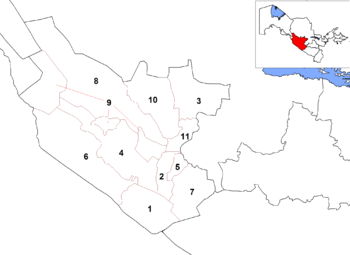Bukhara Region
Bukhara Region
Buxoro viloyati Бухоро вилояти | |
|---|---|
Region | |
UTC+5 (not observed) | |
| ISO 3166 code | UZ-BU |
| Districts | 11 |
| Cities | 11 |
| Townships | 3 |
| Villages | 121 |
| Website | buxoro |
Bukhara Region (Buxoro Region) (
Buxoro Region is divided into 11 administrative districts and two district-level cities. The capital is
The climate is a typically arid continental climate.
The old city of

The Bukhara Region has significant
Administrative divisions

The Bukhara Region consists of 11 districts (listed below) and two district-level cities: Bukhara and Kogon.[1][5]
City of Bukhara includes the municipality of Bukhara itself, as well as two rural communities (Otbozor, Shirbuddin).[5]
| Key | District name | District capital |
|---|---|---|
| 1 | Olot District | Olot |
| 2 | Bukhara District | Galaosiyo |
| 3 | Gʻijduvon District | Gʻijduvon
|
| 4 | Jondor District | Jondor |
| 5 | Kogon District | Kogon |
| 6 | Qorakoʻl District | Qorakoʻl |
| 7 | Qorovulbozor District | Qorovulbozor |
| 8 | Peshku District | Yangibozor |
| 9 | Romitan District | Romitan |
| 10 | Shofirkon District | Shofirkon |
| 11 | Vobkent District | Vobkent |
There are 11 cities (
History
The Bukhara region has always been ethnically diverse in origin, mainly populated by
Main sights
Ulugbek Madrasah is a memorial to Abdul Khaliq Ghijduwani, located in the city of Gijduvon in the Bukhara region of Uzbekistan. It is one of the ancient and renowned madrasas of Bukhara, also known as the "Fayziya Madrasah." Presently, it is also referred to as the Mirzo Ulugbek Madrasa.[8][9] This prestigious educational institution was built in the Hijri year 836 (corresponding to 1432/33 in the Gregorian calendar) beside the grave of Shaykh Abdul Khaliq Ghijduwani, with a two-story structure made of baked bricks.[10][11] The Ulugbek Madrasah, established by Ulugh Beg, is the third and last madrasa he founded, relatively smaller and simpler compared to the Ulugbek Madrasah in Bukhara and Samarkand.[12][13][14]
References
- ^ a b c "Oʻzbekiston Respublikasining maʼmuriy-hududiy boʻlinishi" [Administrative-territorial division of the Republic of Uzbekistan] (in Uzbek). The State Committee of the Republic of Uzbekistan on statistics. July 2021. Archived from the original on 4 February 2022.
- ^ "O'zbekistonda eng ko'p aholi qaysi viloyatda yashaydi?". Qalampir.uz (in Uzbek). Retrieved 2022-02-10.
- ^ a b c Urban and rural population by region, Bukhara regional department of statistics (in Uzbek).
- ^ "Investment Potentials of the Bukhara Region". Diplomat. Retrieved 22 February 2019.
- ^ a b c "Classification system of territorial units of the Republic of Uzbekistan" (in Uzbek and Russian). The State Committee of the Republic of Uzbekistan on statistics. July 2020.
- ^ Goodman, Peter. "Bukharian Jews find homes on Long Island", Newsday, September 2004.
- ^ Finke, Peter, and Meltem Sancak. “To Be an Uzbek or Not to Be a Tajik? Ethnicity and Locality in the Bukhara Oasis.” Zeitschrift Für Ethnologie 137, no. 1 (2012): 47–70. http://www.jstor.org/stable/23333538.
- ISBN 978-9943-8188-7-3.
- ISBN 978-9943-4728-2-2.
- ^ "Ulug'bek madrasasi". autotravel.ru. Retrieved 2023-11-17.
- ISBN 978-9943-7559-5-6.
- ^ "Гиждуван Медресе Улугбека". www.turkestantravel.com. Retrieved 2023-11-17.
- ^ "Buxoro shahridagi Ulug'bek madrasasi tarixi va rasmlari". ilmlar.uz. Retrieved 2023-11-17.
- ^ Soviet encyclopedia of Uzbekistan. XI roof. Tashkent: General editorial office of the Uzbek Soviet Encyclopedia, 1978 - 656 pages
External links
- Official website
- Kropotkin, Peter Alexeivitch; Eliot, Charles Norton Edgcumbe (1911). . Encyclopædia Britannica. Vol. 4 (11th ed.). pp. 156–157.

